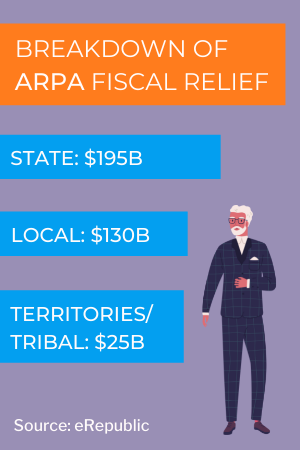
State and local governments will procure $119 billion in technology products and services this year, according to Government Technology. Many of these services will be paid for using funds through the $1.9 trillion federal American Rescue Plan Act (ARPA). Keep reading to see how government organizations are planning to allocate ARPA funding and the growing emphasis on virtual public engagement
How American Rescue Plan Act (ARPA) funding is creating unique opportunities to improve public engagement

Many technology services that benefit the government and the public can be purchased using ARPA funds, including those to enhance public engagement.
State and local governments learned a valuable lesson last year from the pandemic: virtual tactics and remote access to public meetings create a more democractic process and dramatically rose public attendance.
The City of Asheville hosted 150 residents while overcoming security and equity hurdles
View a Mini Case Study here.
A recent survey* found key insights into government operations in 2020-21, including that 97% of the survey respondents had adopted technology for Virtual Public Meetings. In addition, 83% of respondents believe technology adopted specifically for community engagement will be permanent.
The virtual public engagement dilemma: Equity & Access vs. Know How & Compliance
The ability to participate remotely has shown impressive results and improvements across the public engagement spectrum. Benefits include increased attendance at meetings, greater diversification and inclusion among residents, and more public comments to supplant government decision making.

However, for many jurisdictions, virtual public meetings proved to be extremely challenging. The primary obstacles for most of these jurisdictions had to do with a lack of training and inadequate technologies strung together to address the different tasks required to successfully convene a virtual public meeting. In the absence of a full service, end-to-end solution to manage the virtual proceedings, the experience on both sides was less than satisfactory while challenging compliance with their state’s Sunshine law.
This creates an unavoidable truth for government organizations:
Virtual tactics and remote resident access create more public participation and increase equity, but can create compliance concerns.
5 Big Factors That Are Driving Governments’ Motivation For Procuring A Dedicated Public Engagement Technology Platform
Government organizations should consider the following when allocating ARPA funding for public engagement software:
-
- With remote resident participation, public engagement has increased exponentially. That is great news, especially given that:
- Attendance has not only increased, but has also brought a more diverse group of residents. Easier access enables many community members who could not or prefer not to attend meetings or events in person, with government organizations meeting people where they are.
- Third, and related to improved access, online public engagement and VPMs enhance government transparency and accountability: two important elements that build trust and compliance.
- Governments can expect sharp cost reductions in time, staff capacity, and technology with increased stability and security. Many online meetings carried out by state and local governments over the last year required more of all three, including personnel who would not typically be involved in administering a public meeting.
- Finally, scores of state legislatures are placing their stamp of approval on virtual meetings. During the current legislative sessions, lawmakers are rewriting current public meeting laws with language that enable their expanded use virtually due to Covid and to increase public engagement and preferences of public officials and residents.
How ARPA funding can have real impact for public engagement
The question becomes how will government respond to the growing expectation from residents to be able to participate remotely and virtually?
It’s unrealistic to expect staff to become tech experts or piece together a series of softwares — the time and effort of which might outweigh the benefits, even given the call for more access and equity in the public process.
When looking for the right public engagement software for remote resident participation, governments should prioritize:
-
- Automatic comment documentation
- Data storage and management
- Multilingual translation and captioning
- Multiple options for collecting public feedback before, during, and after a public meeting
Through automating, centralizing, and archiving public engagement, state and local governments can ensure remote participation in public meetings complies with state Sunshine laws—a challenge where many jurisdictions faltered during the last year.
The Takeaway:
Whether you are a CIO, a PIO, an elected official or staff, you have a reason to be an advocate for more public participation through technology.
Embrace the new era of public engagement and reap the benefits for government, for the public, and for our democracy for years to come:
Contact Us to learn more.



